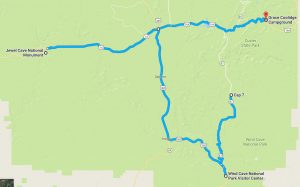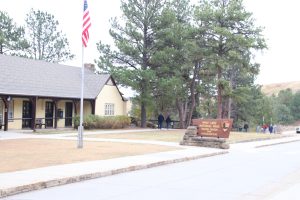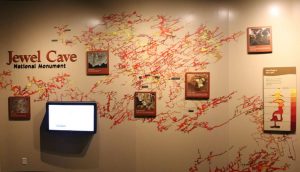As we left the Wildlife Loop Road, we headed south on Hwy 87 towards Wind Cave National Park. Seeing that Kathy had her Passport, we figured we’d take the opportunity to get a couple more cancellations – one at Wind Cave National Park and a second at Jewel Cave National Monument. Both parks were in range and the drive would give us an opportunity to see more of the Black Hills.

The caves in Wind Cave are reportedly some of the world’s oldest caves initially forming over 320 million years ago. They were formed through the eons by combinations of erosion, upheaval, and more erosion. Found by settlers in 1881, the complex cave system in the park includes over 100 miles of explored passages. Barometric wind studies, however, estimate that only 5% of the total cave has been discovered.

After our visit to Wind Cave, we headed out to another cave area, Jewel Cave National Monument. Jewel and Wind caves are about 20 miles apart “as the crow flies”, about 30 miles by car. Neither of us had ever been to Jewel Cave so we had no expectation for what we would find. Quite honestly, I kind of figured it to be the “poor step child” to Wind Cave. Nonetheless, the stop would provide Kathy with another cancellation in her passport for the national parks and monuments.
We found the road to Jewel Cave on Hwy 16 just west of Custer. The sign and road were unassuming and led to the site’s visitor center. Kathy got her passport stamped and we decided to visit the small museum to find out more about the park.
It turned out the story about the park was fascinating!
Much like the companion Wind Cave, settlers stumbled on Jewel Cave in the early 1900’s when two miners found an entrance that was too small for people to enter with a blast of cold air coming out. They proceeded to open the entrance and investigate the cave, finding low ceilinged rooms coated with “jewel-like” crystals. The commercial value of the “jewels” was low, but there were attempts to develop the cave site as an entertainment and amusement center.
The attempts weren’t successful, and the two miners eventually sold the claim back to the government and in 1908, the cave was proclaimed a national monument by Teddy Roosevelt. Development was slow until 1959, with approximately only two miles of the cave discovered and mapped. With questions of the significance of jewel cave being raised, a geologist who enlisted the aid of wo rock climbing enthusiasts embarked on a more dedicated exploration. By 1961, the discovered and mapped length was 15 miles. The discoveries led to more investment and interest in the cave system into the early 1970’s.
Exploration has continued, and today jewel is the third longest cave in the world with an explored length of just under 192 miles to depths of 830 feet. The museum includes a painted mural that shows the extent of the cave system.

Because the structure and development of the cave is like Wind Cave, there is speculation that the two caves may be joined and exist as a single cave. My impression of Jewel Cave being a poor step child to Wind Cave was totally blown out of the water by this visit.
We didn’t have a chance on this trip, but maybe in our future travels we’ll have a chance to do a bit of spelunking in the caves underneath the Black Hills.
